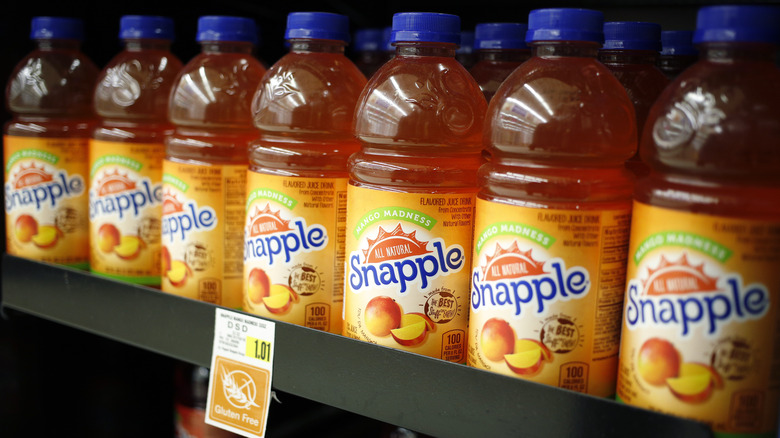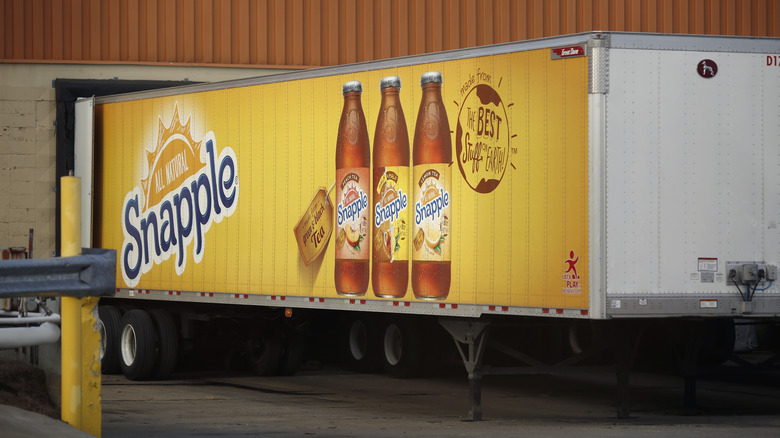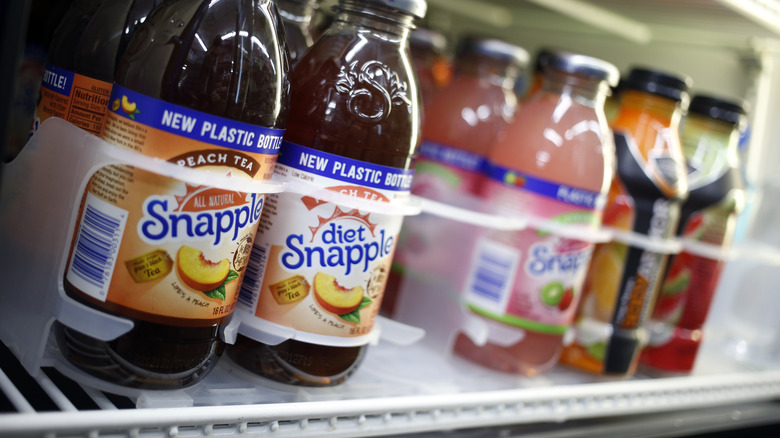The Boozy Origin Behind Snapple's Name
Snapple rose from humble beginnings to become one of the most recognized names in the beverage business, built on the promise of natural ingredients and bottle caps printed with fun facts. The most remarkable fact of all, though, is that any of us ever heard of Snapple to begin with. At the outset, nothing indicated that this ragtag juice company would be able to sell a single bottle of their product, much less nearly 55 million cases in 2019, according to Statista.
Snapple was founded in 1972 by the most unlikely trio of entrepreneurs you could imagine. Leonard Marsh and his brother-in-law Hyman Golden were window washers in New York City, and their good friend, Arnold Greenberg operated an East Village health food store converted from his parent's Jewish grocery. This bold triumvirate believed there was a business to be made selling natural fruit juices aimed at young, health-conscious consumers, but they had a problem. Not one of them knew the faintest thing about making juice.
At first, Marsh, Golden, and Greenberg called their company Unadulterated Food Products. Not the catchiest option, but they would soon find inspiration for a new name amidst a botched batch of juice. One of the first products they sold was carbonated apple juice, and on one particular occasion, the juice fermented in its bottles, essentially turning into apple champagne. When the pressure inside the bottles became too much, the caps popped right off. This led to the portmanteau of Snapple, or "snappy" apple juice.
How Snapple conquered the beverage business
Considering the fact that they named their company after a manufacturing accident, you wouldn't think the founders of Snapple stood much of a chance in the cutthroat world of business, but their inexperience actually proved to be a strength. Snapple became famous for "out-of-the-box" thinking, being among the first brands to capitalize on the health food trend of the 1980s that would also see diet sodas and light beers come to prominence.
Marsh, Golden, and Greenberg also took an unusual approach to marketing that made Snapple stand out from its competitors, according to Thrillist. For advertising, they contacted their favorite radio host, Howard Stern, who ended up doing ad reads for Snapple for years, and purportedly thought so highly of the product that he would give them extra airtime beyond what they'd paid for. When the Snapple group heard that Rush Limbaugh was also a fan of their product, they got him to advertise it too, giving them a radio presence on both ends of the political spectrum.
The best marketing move in Snapple's history has to be the 1990s ad campaign featuring the iconic mascot known simply as "the Snapple Lady." Armed with a thick New York accent, the Snapple Lady sat at a desk, fielding calls from customers and dishing out snappy advice. In true Snapple fashion, this ad campaign was a little unusual. Instead of hiring a professional actor for the part of the Snapple Lady, the company turned to Wendy Kaufman, who ran their customer service department.
Those famous Snapple Real Facts aren't always true
The unique quirkiness that defined Snapple's early advertising was largely lost when the company went through a series of sales, first to Quaker Oats in 1994, then to Triarc in 1997, and finally to Cadbury Schweppes, which spun it off into the Dr. Pepper Snapple Group. Since then, the company's most significant marketing move has been Snapple Real Facts, the fun facts now printed on the underside of every bottle cap. According to the Washington Post, this began back in 2000 when Snapple began printing jokes on their bottle caps. However, the jokes were pretty unfunny, like "If the #2 pencil is the most popular, why is it still #2?" What a lark.
In 2002, Snapple's marketing team decided to pivot to printing factoids on their bottle caps. In the two decades since they have released over 1,400 "Real Facts," according to Pop Sugar. The problem is that these Snapple Real Facts aren't always as real as they purport to be. Snapple claims to verify every one of its facts, yet a number of them have proven to be incomplete or inaccurate. One notable instance of this was Real Fact #70, which stated "Caller ID is Illegal in California". This is not, in fact, the case, leading a California telecommunications company to contact Snapple and demand a revision. They got their wish, and today, Real Fact #70 reads, "A jiffy is 1/100 of a second". This, however, is also false, as the BBC explains that physicists actually define a jiffy as 1/50 second. Try again, Snapple.


